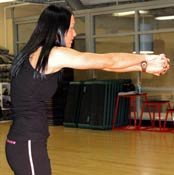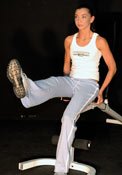
TOPIC: How Should One Exercise On A Long Flight?

The Question:
If you're on a long flight you shouldn't be concerned about exercising for muscle or fat loss, but rather for improving circulation. But when there is so little room and so many people, what should one do?
How should one exercise on a long flight?
How often should one move around?
What are possible consequences of not moving around on long flights?
Show off your knowledge to the world!
The Winners:
- EAGLES56
Prizes:
- 1st place - 75 in store credit.
- 2nd place - 50 in store credit.

1st Place - EAGLES56

If you're on a long flight you shouldn't be concerned about exercising for muscle or fat loss, but rather for improving circulation. But when there is so little room and so many people, what should one do?

How should one exercise on a long flight?
Given the confines of a plane, going for a jog is simply out of the question. That said, how can one possibly exercise on a long flight when there's typically even less space than a common work cubicle?
Let's pretend you're stuck in the window seat with a veteran traveler asleep beside you, limiting your room and blocking your way to the aisle. I recommend waking the person next to you and walking up and down the aisle after of couple hours and being sure to move your arms around. However, some people may opt to keep to themselves, which yields only the small seat space and limited leg room. What can you do!?

The '1000 Mile-High' Workout
- *If you can, get out into the aisle and walk around while moving your arms, if not, read on ...
Exercises:
- Calf Raises: 2 x 30
Shown With Machine.
- Shoulder Rotations: 2 x 20
- Leg Extensions: 2 x 20
- Ankle Rotations: 2 x 20
- Neck Rolls: 2 x 10 (both forward and backwards)
 Click Here For A Printable Log Of EAGLES56's 1000 Mile-High Workout.
Click Here For A Printable Log Of EAGLES56's 1000 Mile-High Workout.
Additional (Simple) Stretches:
- Reach for the Sky: Simply raise your arms above your head to lightly stretch out your shoulders, upper back, arms and chest.
- Arm Extensions: Extend your arms in front of yourself as if you were pushing someone away. Feel free to push off of the seat in front of yourself - just don't irritate other passengers.
- Leg Extensions: Stiffen your legs in front of yourself and point your toes away from your body.
- The idea is to promote circulation in the restricted amount of space. The above is a small group of exercises which will help increase blood flow. For those who would rather increase circulation in a less 'robotic' manner, simply keep moving in your seat. By all means, dance in your seat if you'd like.
- After any long trip (including an extended period of immobility), I would recommend light cardiovascular exercise (such as a brief brisk walk or jog up a couple flights of stairs) and full body stretching to help loosen the body up.
As a student, I often notice that my hips tighten up with extended periods of time sitting - which negatively affects my squat. Focus on lower body exercises and stretches since the lower body is often forgotten.
Other simple ways to promote circulation:
- Avoid crossing your legs
- Do not consume caffeine and other diuretics
- Stay hydrated
- Avoid wearing tight clothing

How often should one move around?
- Depending on the length of the flight, I would aim to increase circulation at least every 1-2 hours. Try to keep moving your legs the entire time. This could be as simple as tapping your feet once in a while to shaking your legs back and forth as if you had to go to the bathroom. The more you move around the better, but be considerate of those around you - as they may be trying to rest.

What are possible consequences of not moving around on long flights?
- Although the vast majority of the public should be fine, failure to move around may cause minor problems for everybody. "For the majority of people, though, there is no risk."
3
Check with your doctor to see if you run any additional risk. Those over 40 should take extra precautionary measures.
- Lack of movement may cause numbness in the extremities, stiff legs ('Charlie Horses'), tightened muscles, poor mobility/trouble upon getting up and blood clot formation.
Long flights have been linked to blood clot formation in the legs (DVT) 1,2,3,4. Deep vein thrombosis (DVT) can be lethal. The risk of DVT increases dependant on the length of the flight.2 Wearing compression pants offered by some airlines appears to decrease the risk of clot formation.3 Promoting circulation will also reduce the risk of attaining clots. 'The precautions passengers can take to avoid DVT include drinking plenty of water and exercising during the flight.'1
References:
- BBC News Online: Airlines Admit Blood Clot Risk
- BBC News Online: Flight Blood Clots 'Hit One In Ten'
- BBC News Online: Longer Flights Have 'Greater DVT Risk'
EAGLES56









